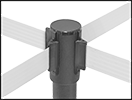Bollards
Closed-top bollards have a welded top. Bollards with an eyelet have a welded eye for attaching chain.
Open-top bollards allow you to pour in cement for added strength. The 24" to 42" high bollards include an end cap.
| Ht. | Installed Ht. | Dia. | Material Thick. | Material | Color | Each | |
In-Ground Mount | |||||||
|---|---|---|---|---|---|---|---|
| 84" | 42" | 6 5/8" | 1/2" | Powder-Coated Steel | Yellow | 00000000 | 0000000 |
Build-Your-Own Chain Barriers
Mix and match posts and chain to create a barrier that suits your needs.
All posts have a removable top. Fill the base with sand or pea gravel for added stability. Styles A and C have a hook connector at the top of the post to attach chain on either side. Style C has an 8" stake end for driving into the ground.
Warning: Chain is not load rated. Do not use for overhead lifting, towing, or similar applications.
Post | ||||||||
|---|---|---|---|---|---|---|---|---|
| Style | Shape | Ht. | Dia. | Material | Environment | Color | Each | |
Solid with White Ball Top | ||||||||
| C | Round | 27" | 2" | Polyethylene | Outdoor | Black | 0000000 | 000000 |
Receiver Posts for Freestanding Retractable Belt Barriers

Provide an end point for a belt barrier.
These posts are connection points only and have no belt.
Posts with a spiked base have an 8" high spike, so you can insert them into the ground.
Post | Housing | Base | ||||||||||
|---|---|---|---|---|---|---|---|---|---|---|---|---|
| Color | Dia. | Material | Environment | Ht. | Color | Material | Material | Dia. | Weight, lbs. | No. of Connection Points | Each | |
In Ground-Mount | ||||||||||||
Spiked Base | ||||||||||||
| Yellow | 2 1/2" | PVC | Outdoor | 38" | Black | Nylon Plastic | Steel | 5" | 5 | 4 | 000000000 | 0000000 |
Two-Way-View Marking Reflectors
Reflectors are visible from both sides for areas where traffic moves in two directions.
Two-Way-View Bounce-Back Marking Reflectors
These flexible reflectors return to the upright position after contact. They are visible from both sides for areas where traffic moves in two directions.
Use the post driver to help sink Style D reflectors into the ground.
Reflectors | ||||||||||||
|---|---|---|---|---|---|---|---|---|---|---|---|---|
Reflector | Post | Post Drivers | ||||||||||
| Ht. | Wd. | Ht. | Wd. | Reflector Material | Reflector Color | Material | Color | Each | Each | |||
| D | 6" | 3 1/8" | 66" | 3 3/4" | Plastic | Yellow | Plastic | White | 0000000 | 000000 | 0000000 | 0000000 |
| D | 6" | 3 1/8" | 72" | 3 3/4" | Plastic | Yellow | Plastic | White | 0000000 | 00000 | 0000000 | 000000 |
| D | 6" | 3 1/8" | 84" | 3 3/4" | Plastic | Yellow | Plastic | White | 0000000 | 00000 | 0000000 | 000000 |



























